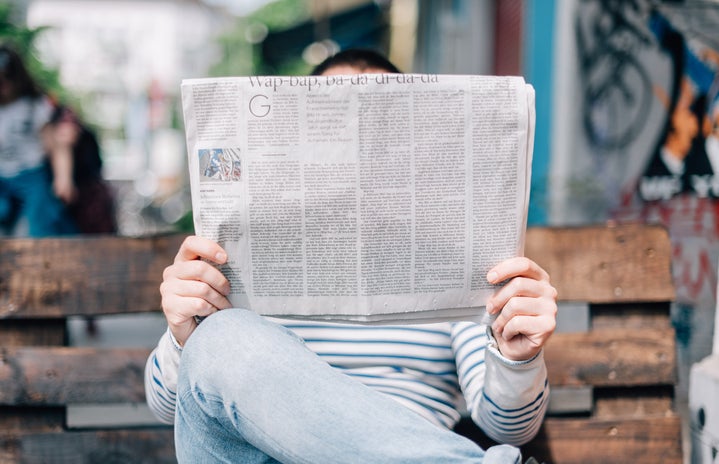Two Saturdays ago, as the TV played CNN reels of White House physician, Dr. Conley, and his infamously enigmatic Trump-coronavirus diagnosis press briefings in the background, I thought to myself: “Where in the world am I to begin if my future children ask me to explain what happened in 2020?” After all, I had almost completely forgotten the breaking news about Donald Trump’s tax avoidance. That headline had broken just six days prior.
It seems as though major developments in the news come almost every hour. The phrase relating news media to a “collie chasing a foil ball” has become all too real, and just as it is impossible for the proverbial collie to chase twenty-plus balls at the same time, it is impossible for the human brain to keep up with the overload of information served to us every day. We often place headlines into vacuums of space, failing to recognize the interconnectedness of events that break. Journalists must reconsider how news is presented in order to keep the public analytically engaged, just as we must learn to consume news wisely.
The extensively large volume of news that is disseminated daily is having a profound effect on public relationships with news media. A study by University at Albany’s Chang Sup Park, Ph.D. found a strong correlation between perception of news overload and news avoidance, while a 2017 report from The Reuters Institute found that a whopping 57% of the worldwide population “sometimes” or “often” avoided news (Park). It’s reasonable to assume that news overload is a major culprit behind that 57%. At a time like this (i.e. an election season among a global public health crisis, social justice movements, and climate peril — just to name a few) it is imperative that we not only stay up to date on the truth of our social and political atmosphere, but that we’re able to piece together the seemingly unrelated headlines. Just because I’d just learned that the President was diagnosed with COVID-19, that does not mean that the previous week’s major headline about the mere $750 he paid in federal income taxes in 2016 was no longer relevant or important. In fact, as a voter, I can deduce that because Donald Trump failed to follow simple financial responsibilities, his COVID-19 diagnosis most likely was due to a failure to follow public health responsibilities, therefore, I must ask myself: how responsible of a presidential candidate is he? Other than the vote itself, a voter’s greatest asset is their level of information; votes are only as valuable as the level and quality of information they are based upon. So how are journalists to present such a large amount of news in a way that avoids overwhelming the audience? How must journalists engage with the public to connect the dots of news headlines?
On the other hand, ultra-fast-paced news cycles have become a source of twisted entertainment for some. Like your go-to guilty pleasure TV show, constant consumption of breaking news fulfills a type of “FOMO” (a.k.a. fear of missing out). Take the case of English professor, Karen Roggenkamp, who admits that “‘every time I put my phone down or turn off the radio, I feel a crush of not knowing if I am missing any news updates’” (Izadi). Karen is not alone. As beings designed to be aware of our surroundings, it is only natural to respond to the crises at hand with a desire to monitor the situation. And when news media is able to constantly provide a fresh rush of information, leaving audience members hungry for more, this prolonged state of awareness is not particularly healthy, in a mental and emotional sense. So how must journalists be responsible for the pace at which important news is heard?
Between news avoidance and news addiction, it may seem impossible for news media outlets to satisfy the needs of the news-consuming public, while still being able to report current developments and relate them to past headlines. Enter commentary-based journalism.
Journalism that is more analytical in nature allows for discussion around a headline. It provides an opportunity to incorporate previous breaking news with novel events and elaborates upon the significance of the context in which the current happenings operate within. Instead of simply spewing breaking news headlines in a whirlwind blur, it is the responsibility of journalists to provide contextual details that may have been lost among the extensive, ever-growing library of new stories. Context matters. It is the difference between a properly informed citizen and a citizen who misses the nuance of our societal atmosphere.
As consumers of news, it is our responsibility to seek out commentary-based journalism. For instance, editorials provide discussions around current events, meant to engage with the reader by inviting them to consider a perspective; to reflect on the topic and its complexity. Obtaining news in this manner allows for an awareness of the multiplicity and interconnectedness of issues and information – a key aspect of better understanding the world in which we live.
If journalists and consumers alike follow this model of a shifted form of news reporting, gone will be the days where we catch ourselves forgetting about major events that occurred only several days before. When our children and grandchildren ask us the loaded question: “What happened in the year 2020?” commentary-based journalism is our only hope for being prepared to answer.
Sources
Izadi, Elahe. “Yes, the News Cycle is Driving You Mad.” The Washington Post, Oct 12, 2020.
ProQuest, http://ezproxy.msu.edu/login?url=https://www-proquest-
com.proxy2.cl.msu.edu/docview/2449771639?accountid=12598.
Park, Chang S. “Does Too Much News on Social Media Discourage News Seeking? Mediating
Role of News Efficacy between Perceived News Overload and News Avoidance on
Social Media.” Social Media + Society, vol. 5, no. 3, 2019. ProQuest,
http://ezproxy.msu.edu/login?url=https://www-proquest-
com.proxy2.cl.msu.edu/docview/2375715624?accountid=12598,
doi:http://dx.doi.org.proxy2.cl.msu.edu/10.1177/2056305119872956.


